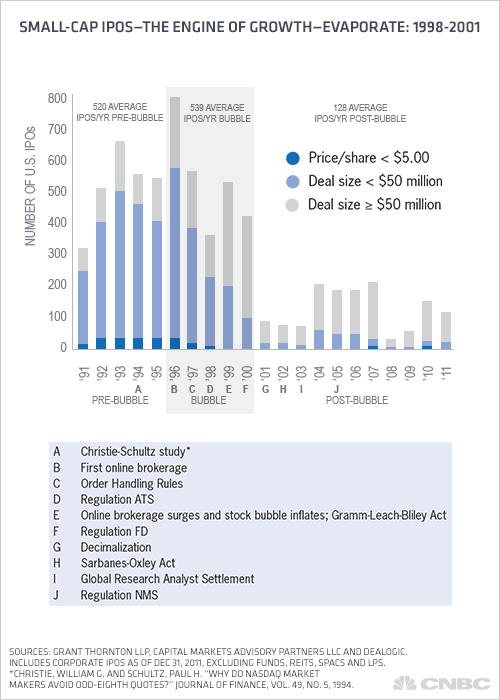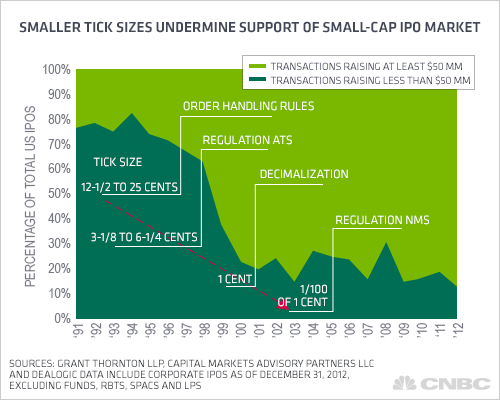Spawned during the late 1990s market boom by two important events—the conversion to electronic markets and to penny-increment "tick sizes" (the primary increment by which stocks are bought or sold today)—decimalization replaced the fraction-based quote-driven system that sustained an efficient, functional IPO market for decades.
The old system not only brought thousands of small companies public, but created adequate incentives to sustain market interest and liquidity long after the first day of trading.
At the time, decimalization was sold as a way to save investors money while making stock markets more competitive with their international counterparts. Indeed, it spawned massive, speed-oriented trading systems around the world. But tragically, it's also the system that left America's most important job creators – entrepreneurs – out in the cold.
(Read More: What's Right and Wrong with Stock Trading System)
Imagine a 10-year span where promising small-cap companies like Apple, Microsoft or Intel couldn't find an investment bank to take them public. Imagine that their only liquidity option would be selling out to a big corporation before their prime. Imagine the staggering potential job loss -- as Berkeley economist Enrico Moretti points out in his 2012 book "The New Geography of Jobs," every new tech job creates five more jobs in the service sector. Finally, imagine the history of American business if these bellwether names hadn't been able to fund, innovate, hire or grow independently in the public markets.
Now stop imagining. This is literally the decade we just lived through.
After years of discussion, it's finally time we rebuild the broken small-cap market and the IPO system with a ridiculously simple solution – putting investors, job seekers and entrepreneurs ahead of traders.
Real change could start today.
The background
The meeting at the SEC is an outgrowth of the 2012 JOBS (Jumpstart Our Business Startups) Act enacted last April. The law created an "IPO on-ramp" by requiring the SEC to "…conduct a study examining the transition to trading and quoting in one penny increments, also known as decimalization…." The analysis is expected to examine the decline in the number of IPOs, aftermarket liquidity, and the ability of Wall Street to support small (below $2 billion in market value) and mid-cap (between $2 and $10 billion in market value) stocks. There's been ample criticism of the act since the signing, most notably for the SEC's tardiness in implementing new rules covering Regulation D and private markets, legalizing crowdfunding and to fix the poorly crafted and seldom-used Regulation A guidelines covering public offerings of $5 million or less.
(Read More: Man Vs. Machine: The New Kings Of Wall Street)
Those talks can and will continue. But penny-increment trading for small-cap companies needs to end right now.
Here's why.
At a time of protracted record-low interest rates and unprecedented modern government intervention to restart our economy, our greatest potential job creators – companies under $2 billion in market value – need a new stock market that welcomes back individual investors, institutional investors, corporate issuers and the value-added intermediaries needed to create liquidity through research, sales and capital committed to trading.
As the following chart shows, the small IPO market began a steep decline after 1996 that led to a near-collapse by 2001:




